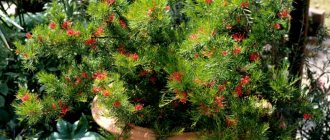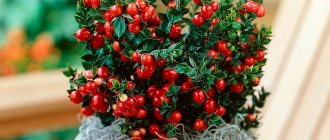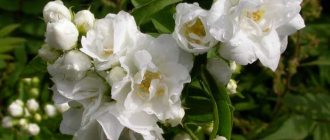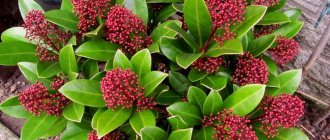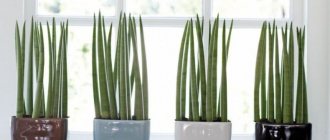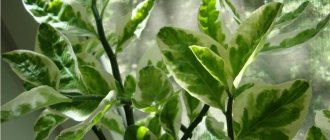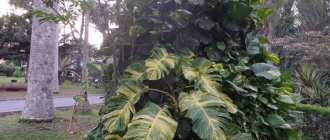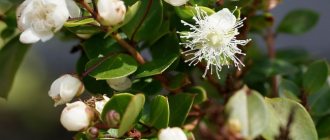The alpinia plant got its name thanks to the botanist from Italy Prospero Alpini. Under natural conditions, the plant is located in tropical or subtropical places. Therefore, in our area, flower growers grow it at home.
Author of the article
Maxim Sverchkov
Professional biologist and breeder with extensive experience and experience.
Landing, transplant
Alpinia prefers light soils: a mix of leaf soil, humus, peat in a one-to-one ratio and sand (0.5). The plant is placed in a wide, shallow pot, with drainage (expanded clay, pebbles, etc.) placed on the bottom. From April until mid-autumn, alpinia needs feeding twice a month, alternating organic fertilizers with mineral ones. In winter, feeding stops.
Transplantation is carried out at the very end of winter or at the beginning of spring using the transshipment method. The earthen lump is carefully removed from the old pot so as not to damage the roots, and placed in a larger container.
The difference between the sizes of the two pots should be small - up to 1 cm. Young alpinias are replanted every year, then as needed.
What does alpinia suffer from?
This plant does not have any typical diseases, but they can be caused by errors in care. If the plant is kept in a colder than recommended temperature range for a long time, leaf necrosis may develop. The lower leaves turning yellow around the edges may indicate a lack of magnesium in the soil; in this case, you should pay attention to the content of this mineral in the complex fertilizer or use special fertilizers. You can take a simpler route - once a month, add a pinch of Epsom salt to the soil before watering, and very soon the leaves of the flower will look bright and healthy.
Temperature, watering
Alpinia is light-loving; in good light it produces more flower stalks, but in summer it is harmed by direct sunlight. A comfortable temperature for it does not exceed +25 degrees in summer, in winter it is cooler, up to +18. In cold weather, it is better for the plant to be on the south side. Alpinia is an individualist, she does not like neighbors nearby, there should be free space around her.
The soil should be moist from spring to autumn. Water the alpinia with soft, settled water. It is convenient to place the pot with the plant in a tray with small pebbles and water. Additionally, spray the leaves with water at room temperature. Every week the leaves should be wiped from dust and washed with warm water in spring and summer.
Due to lack of moisture and very dry air in the apartment, alpinia leaves can dry out and their tips darken. This is a sign of a weakened plant; spider mites can settle on it.
Description of the flower
The alpinia flower has more than 250 species. Basically they all grow in southern Asia. Thailand is the birthplace of these cultures. Botanists often described it as having medicinal properties.
The rhizome of alpinia is long with strong branching. It has a red tint. Stems sprout from them. There are up to forty stems per crop. Peduncles and inflorescences appear on them. They have the shape of a spikelet. The color may vary depending on the type: red, white, yellow.
They are located at the very top of the stems. The leaves are oblong oval in shape. Some species have upward-growing flowers, and some have drooping inflorescences. After the flowering period, the crop produces a fruit in the form of a box. When broken, the leaf blades smell pleasant.
The root system is sometimes used as a spice or for making medicines. Alpinia roots can reach one meter in length.
The shoots are tall. They can reach one and a half meters in height. Tassels with white flowers form on the upper part of the stem. Fruit seeds are usually used to propagate the crop.
The spice is used for fish, meat and vegetable dishes. You can make infusions and medicines.
In appearance, alpinia resembles ginger. You can buy alpinia at any specialized flower shop.
Reproduction
Alpinia is propagated in the spring when it is transplanted. The rhizome is cut into separate fragments, each placed in a separate pot, the sections should be sprinkled with fine charcoal. The soil consists of turf, humus and sand in equal proportions.
You can grow alpinia from seeds. Only the seeds quickly become inactive; they must be used as soon as collected. The seed is planted in January in the same mixture as rhizome fragments, the temperature for germination is from +22 degrees. Watering is constant; emerging sprouts need to be sprayed and ventilated.
Alpinia care
Only certain types of plants can be grown indoors: cerumbet, variegated and variegated. Among flower growers, bushes with a small height (about thirty to fifty centimeters) are common. Caring for alpinia at home is quite simple.
- The culture requires high humidity and moderate watering. In winter, the flower begins to rest, so it needs to be watered less often. The leaves are wiped with a damp cloth to remove dust and dirt.
- In winter, the air temperature should be no more than seventeen degrees, and in summer no more than twenty.
- Alpinia propagation occurs by growing seeds or dividing the root system. The second method is carried out during plant transplantation in the spring. The divided crops are planted in different wide containers.
- Harmful insects practically do not affect alpinia. The flower is resistant to many diseases. The most important thing is to properly care for it. Overmoistening of the soil leads to rotting of the roots and death of the crop.
We also recommend that you read the article about the plant chlorophytum.
Alpinia as a medicine
Parts of the plant, mainly its rhizome, contain various flavonoids, essential oils, and a small amount of tannins.
In folk medicine, alpinia (Alpinia galanga) is used internally:
- for intestinal infections
- bronchitis
- rheumatism
- type 2 diabetes
- allergic rhinitis
- to improve digestion
A tincture is prepared from the rhizome for external use for various fungal diseases.
Eastern medicine recommends alpinia seeds for
- malaria
- cholera
- toothache
- various gastrointestinal diseases
The seeds contain ingredients that help restore salivation, gas secretion, appetite, relieve headaches, and seasickness. Alpinia is also believed to help strengthen the immune system.
Popular types of indoor alpinias
In indoor culture, the most common plants in nature and cultivated in Asia are poorly represented. The calling card of the genus Alpinia officinarum , whose appearance is standard due to its large lanceolate sessile leaves and dense apical panicles of inflorescences, is one of the most universal medicinal crops in the arsenal of oriental medicine.
Having become famous for its use in the treatment of cholera and malaria, it is still used very widely today - from treating digestive problems and diseases of the digestive tract to toothache, headaches and even seasickness.
Basically, the healing properties are characteristic of the roots of the plant, which contain unique resins and essential oils with spicy and bright odors, which are also used to flavor fish, meat dishes and alcoholic beverages. But at home you shouldn’t experiment with collecting them from plants, drying them and using them, preferring ready-made spices.
Among the alpinias there are also more compact and original flowering relatives.
Ribbon alpinia (Alpinia vittata, outdated synonymous name - sanderae ) is one of the most popular and compact types of alpinia. Even in nature, the maximum height of the plant is limited to 80 cm, but in a room this type of alpinia can be limited to half a meter in size.
The shoots are densely leafy, linear up to 15 cm in length, with narrow dark green leaves, on the surface of which white stripes appear brightly. The apical panicles of inflorescences of bright pink flowers seem dazzling and very dense.
Alpinia zerumbet is the most interesting species in terms of the variability of patterns on the leaves. The stems are tall, with lanceolate leaves tapered at the base and unique long drooping racemes of bell-shaped cream flowers with an original yellow-pink lip. Various wide or narrow light yellowish, cream and white stripes are characteristic of all varieties and the basic form of variegata.
Purple alpinia (Alpinia purpurata) is a very beautiful and strict species with a symmetrical arrangement of oval-lanceolate leaves, not as narrow as those of other alpinias, reminiscent of ficuses. The unique red bracts around the white flowers make the narrow panicles of the inflorescences very bright.
Alpinia vittata. © Francisco Alba
Rare species of indoor alpinias
Alpinia calcarata , formerly known as Alpinia bracteata, is an original species whose shoots can grow up to a meter in height, with long-petioled, lanceolate leaves up to 50 cm in length, the color of which becomes lighter closer to the edges of the leaf blades.
This type of alpinia produces orchid-like flowers in drooping long clusters of inflorescences. Green, dry and brittle bracts highlight the beauty of a unique flower with a light beige corolla and red and yellow lips.
Alpinia Kawakami (Alpinia kawakamii, synonymous name - Alpinia Elwesii) - an original species with sessile, long, linear leaves. Straight clusters of inflorescences are very wide, consist of dozens of flowers with a long tube, a white corolla, cilia along the edge of the lobes and an oval large lip with reddish patterns.
Alpinia mutica is a beautiful species with dark, half-meter, narrow spear-shaped leaves and sparse panicles with original white flowers with a unique wide, spotted yellow-orange-red lip.
The smallest-leaved of all alpinia species remains alpinia (Alpinia luteocarpa), whose stems with narrow, lanceolate, red-edged leaves with a strongly pointed tip resemble the fronds of cirrus palms. The dense arrangement of the lobes only emphasizes this effect. Loose clusters of inflorescences with white and red corolla petals look very bright.
Photo of Alpinia plant
Growing conditions for indoor alpinias
Alpinia always looks compact and charmingly dense, especially when young bushes of fashionable variegated varieties are displayed on the shelves. But this plant very quickly reveals its true size and true character. Large, powerful, fast-growing alpinias, even with appropriate control measures, still remain one of the most aggressively growing plants. Moreover: they love free space and require very careful selection of placement.
The transformation of alpinia from a small miracle, restrained and often treated with inhibitors, into a true giant is an amazing sight. And the larger this plant becomes, the more decorative it is.
Alpinias are more demanding of free space and one single point of care. Otherwise, they pleasantly surprise with their unpretentiousness and ability to adapt to conditions that are slightly different from ideal. This is an ordinary heat-loving plant, which, by luck, is accustomed to living in the same temperatures that are typical for ordinary living rooms.
Alpinia zerumbet. © sunshinehorticulture
Lighting and placement
Alpinia is light-loving, but not so much that it is difficult to find a comfortable place for it in the room. Any placement in a place with good lighting will suit her just fine. Alpinias are good in partial shade and in diffused light, but are afraid of direct sunlight.
Even in spring, at the height of the day, it is better to protect the variegated leaves of varietal alpinias from the bright sun by installing diffusing screens. Alpinias feel good not only on window sills, but also near windows; they prefer eastern and western windows to southern ones (but with the latter they can be placed a little deeper in the interior).
Alpinia flowering stimulates increased lighting. Seasonal changes are usually sufficient during the summer, but moving to brighter locations can help encourage the plant to produce more flower stalks.
Finding a place for alpinia where it would be comfortable is not very easy: it loves space, plenty of fresh air and does not tolerate cramped conditions. This beauty will not develop well and will not reveal her true beauty in large groups and in the company of giants. Alpinia is a solitary plant, or at least a conditional solitary one, near which you should leave as much space as its own crown occupies.
Temperature and ventilation
The thermophilia of alpinias can be called legendary. This plant is accustomed to tropical climates and does not like to overwinter in cool conditions. For him, in fact, there is no need to create excellent summer and winter temperature conditions: it is enough to ensure that the alpines are in a place where the temperature never drops below 20 degrees Celsius in the summer and below 15 degrees in the winter.
A wintering regime at a temperature of 16 to 18 degrees is desirable, but not required, because alpinias, with proper care, develop normally at normal room temperatures. But it is still worth considering that during a very warm winter, air humidity is a critical parameter and the plant may not withstand its fall.
Alpinias are heat-loving plants. And despite the love for ventilation and fresh air, it is better not to take them out into the garden or onto balconies for permanent stay, exposing them only on those days when there is no threat of the air temperature falling below the minimum permissible 20 degrees. Cold drafts are unacceptable.
Alpinia purpurata
Diseases, pests and problems in growing alpinia
Alpinias always very clearly signal about improper conditions of maintenance or care. Loss of decorativeness and falling leaves, depressed state and gradual death of shoots are the main symptoms indicating a violation of the most important point of care for alpinias - measures to maintain high air humidity.
This unique plant with a high content of essential oils in its tissues is resistant to pests and diseases and almost never suffers from problems typical for indoor plants.
Alpinia requires regular rejuvenation to maintain its decorativeness and compactness. ©GardenTags
The best varieties of Alpinia
Alpinia: flower photo
- Medicinal alpinia. The plant has large, beautiful leaves and paniculate inflorescences. The rhizomes of medicinal alpinia are used to prepare various seasonings that are suitable for meat and fish dishes. Alpinia officinalis is also used in medicine: it perfectly relieves headaches and toothaches, improves the functioning of the gastrointestinal tract.
- Ribbon alpinia. The plant is quite miniature, reaching 50-80 cm in height. Alpinia leaves are dark green with bright white stripes, and the flowers are a very beautiful dazzling pink color.
- Purple alpinia. The leaves of Purple Alpinia are somewhat reminiscent of ficus, they are wider than in other varieties. The red and white flowers are very beautiful and bright.
- Blunt alpinia. The leaves are spear-shaped and reach 50 cm in length. The flowers are very interesting, white with a red-orange “lip”.
- Bract alpinia. The plant can reach 80-100 cm in height. The green leaves grow up to 50 cm. The beige flowers with a yellow-red lip resemble an orchid.
Links
- Alpinia officinalis
: information on the
GRIN
(Retrieved May 6, 2009) - Alpinia officinalis
: information on the Encyclopedia of Life (
EOL
) website (Retrieved May 6, 2009)
Wikimedia Foundation. 2010.
See what “Alpinia officinalis” is in other dictionaries:
Alpinia officinalis - Alpinia officinalis, Alpinia officinalis - From the ginger family. Grows on Hainan Island and the Leizhoubandao Peninsula (China). Herbaceous perennial up to 1.5 m high. The leaves are arranged in 2 rows, narrowly lanceolate, up to 2 cm wide and up to 30 cm long. The flowers are white, collected in 10 centimeters... ...Homeopathy Reference
Galanga - Galanga, Alpinia officinalis - Syn.: Alpinia officinalis. From the ginger family. The plant is native to Hainan Island and the Leizhouban Peninsula (China). Plants are grown here to obtain medicinal raw materials. Herbaceous perennial plant up to 1.5 m high. The leaves are located... ... Reference book on homeopathy
Alpinia - ? Alpinia ... Wikipedia
Kalgan officinalis - ? Alpinia officinalis Alpinia officinalis Scientific classification Kingdom: Plants Department ... Wikipedia
List of plants - List of plants, illustrations for which are placed in the reference book “Köhler’s Medizinal Pflanzen” Appendix to the article Köhler’s Medizinal Pflanzen Illustrations from the atlas of medicinal plants “Köhler’s Medizinal Pflanzen”... ... Wikipedia
Ginger family (Zingiberaceae) - The ginger family, numbering about 47 genera and more than 1000 species, grows mainly in the forests of South and Southeast Asia, on the islands of the Malay Archipelago and New Guinea. Only a few species of alpinia (Alpinia, table 47, 4), amomuma ... ... Biological encyclopedia
List of plants, illustrations of which are placed in the directory “Köhler's Medizinal-Pflanzen” - This page is an informational list. See also the main article: Köhler s Medizinal Pflanzen ... Wikipedia
KALGAN - 1) (Uzik) is a perennial herbaceous plant from the cinquefoil genus of the Rosaceae family. Grows in damp meadows and bushes in Eurasia. Tanning, medicinal (astringent, disinfectant) and dyeing plant; 2) (lesser galanga or alpinia ... ... Big Encyclopedic Dictionary
Kalgan - 1) plant of the family. pink genus Potentilla. 2) Alpinia officinaria, or lesser galanga (Alpinia officinar), a plant of the family. ginger, growing in the tropics of Asia; rhizomes, exported to Europe, are used in medicine and as a spice.... ... Biological encyclopedic dictionary
galangal - a; m. Herbaceous plant of the family. Rosaceae, with yellow flowers (its rhizome is used in medicine). * * * galangal 1) (Uzik) is a perennial herbaceous plant from the cinquefoil genus of the Rosaceae family. Grows in damp meadows and bushes in... ... Encyclopedic Dictionary
